ASUS AB-P2800 PUNDIT-R User Manual
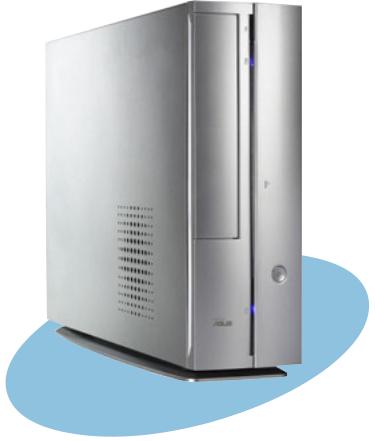
 AB-P2800
AB-P2800
Book Size Barebone System
User Guide

E1611
Revised Edition V2
May 2004
Copyright © 2004 ASUSTeK COMPUTER INC. All Rights Reserved.
No part of this manual, including the products and software described in it, may be reproduced, transmitted, transcribed, stored in a retrieval system, or translated into any language in any form or by any means, except documentation kept by the purchaser for backup purposes, without the express written permission of ASUSTeK COMPUTER INC. (“ASUS”).
Product warranty or service will not be extended if: (1) the product is repaired, modified or altered, unless such repair, modification of alteration is authorized in writing by ASUS; or (2) the serial number of the product is defaced or missing.
ASUS PROVIDES THIS MANUAL “AS IS” WITHOUT WARRANTY OF ANY KIND, EITHER EXPRESS OR IMPLIED, INCLUDING BUT NOT LIMITED TO THE IMPLIED WARRANTIES OR CONDITIONS OF MERCHANTABILITY OR FITNESS FOR A PARTICULAR PURPOSE. IN NO EVENT SHALL ASUS, ITS DIRECTORS, OFFICERS, EMPLOYEES OR AGENTS BE LIABLE FOR ANY INDIRECT, SPECIAL, INCIDENTAL, OR CONSEQUENTIAL DAMAGES (INCLUDING DAMAGES FOR LOSS OF PROFITS, LOSS OF BUSINESS, LOSS OF USE OR DATA, INTERRUPTION OF BUSINESS AND THE LIKE), EVEN IF ASUS HAS BEEN ADVISED OF THE POSSIBILITY OF SUCH DAMAGES ARISING FROM ANY DEFECT OR ERROR IN THIS MANUAL OR PRODUCT.
SPECIFICATIONS AND INFORMATION CONTAINED IN THIS MANUAL ARE FURNISHED FOR INFORMATIONAL USE ONLY, AND ARE SUBJECT TO CHANGE AT ANY TIME WITHOUT NOTICE, AND SHOULD NOT BE CONSTRUED AS A COMMITMENT BY ASUS. ASUS ASSUMES NO RESPONSIBILITY OR LIABILITY FOR ANY ERRORS OR INACCURACIES THAT MAY APPEAR IN THIS MANUAL, INCLUDING THE PRODUCTS AND SOFTWARE DESCRIBED IN IT.
Products and corporate names appearing in this manual may or may not be registered trademarks or copyrights of their respective companies, and are used only for identification or explanation and to the owners’ benefit, without intent to infringe.
2

Table of contents
Notices ........................................................................................... |
|
6 |
|
Safety information .......................................................................... |
7 |
||
About this guide .............................................................................. |
8 |
||
System package contents ............................................................ |
10 |
||
Chapter 1: System introduction |
|
||
1.1 |
Welcome! ............................................................................ |
12 |
|
1.2 |
Front panel (external) .......................................................... |
12 |
|
1.3 |
Front panel (internal) ........................................................... |
13 |
|
1.4 |
Rear panel ........................................................................... |
14 |
|
1.5 |
Internal components ............................................................ |
16 |
|
1.6 |
System dimension ............................................................... |
16 |
|
Chapter 2: Basic installation |
|
||
2.1 |
Preparation .......................................................................... |
18 |
|
2.2 |
Before you proceed ............................................................. |
18 |
|
2.3 |
Removing the cover ............................................................ |
19 |
|
2.4 |
Removing the storage drive assembly ................................ |
20 |
|
2.5 |
Installing a CPU................................................................... |
21 |
|
|
2.5.1 |
Removing the CPU fan and heatsink assembly .... |
21 |
|
2.5.2 |
CPU installation ..................................................... |
23 |
|
2.5.3 |
Re-installing the CPU fan and heatsink assembly |
24 |
2.6 |
Installing memory modules.................................................. |
26 |
|
|
2.6.1 |
Overview ............................................................... |
26 |
|
2.6.2 |
Memory configurations .......................................... |
26 |
|
2.6.3 |
Qualified Vendor List ............................................. |
27 |
|
2.6.4 |
Installing a DIMM .................................................. |
27 |
|
2.6.5 |
Removing a DIMM ................................................ |
28 |
2.7 |
Installing PCI cards ............................................................. |
29 |
|
|
2.7.1 |
PCI slots ................................................................ |
29 |
|
2.7.2 |
PCI card installation .............................................. |
29 |
|
2.7.3 |
Configuring an expansion card ............................. |
31 |
2.8 |
Installing storage drives....................................................... |
32 |
|
|
2.8.1 |
Installing an IDE hard disk drive ............................ |
32 |
|
2.8.2 |
Installing a Serial ATA hard disk drive ................... |
34 |
|
2.8.3 |
Installing an optical drive ....................................... |
35 |
3

Table of contents
2.9 |
Replacing the cover............................................................. |
39 |
|
2.10 |
Removing and re-installing the foot stand ........................... |
40 |
|
|
2.10.1 |
Removing the foot stand ....................................... |
40 |
|
2.10.2 |
Re - installing the foot stand .................................... |
41 |
2.11 |
Power supply unit information ............................................. |
42 |
|
|
2.11.1 |
Voltage selector ..................................................... |
42 |
|
2.11.2 |
Power supply specifications .................................. |
43 |
2.12 |
Connecting devices ............................................................. |
44 |
|
Chapter 3: Starting up |
|
||
3.1 |
Installing an operating system ............................................. |
48 |
|
3.2 |
Powering up ........................................................................ |
49 |
|
3.3 |
Using the system ................................................................. |
49 |
|
|
3.3.1 |
PCMCIA card slot .................................................. |
49 |
|
3.3.2 |
Storage card slot ................................................... |
50 |
|
3.3.3 |
Optical drive .......................................................... |
50 |
3.4 |
Support CD information ....................................................... |
51 |
|
|
3.4.1 |
Running the support CD ........................................ |
51 |
|
3.4.2 |
Drivers menu ......................................................... |
51 |
|
3.4.3 |
Utilities ................................................................... |
52 |
|
3.4.4 |
ASUS contact information ..................................... |
53 |
3.5 |
ATI IGP Catalyst™ .............................................................. |
54 |
|
|
3.5.1 |
Left - click menu ...................................................... |
54 |
|
3.5.2 |
Right - click menu .................................................... |
54 |
|
3.5.3 |
Managing multiple displays ................................... |
55 |
3.6 |
Multi-channel audio feature ................................................. |
57 |
|
Chapter 4: Motherboard information |
|
||
4.1 |
Introduction.......................................................................... |
62 |
|
4.2 |
Motherboard layout ............................................................. |
62 |
|
4.3 |
Jumper |
................................................................................ |
63 |
4.4 |
Internal connectors .............................................................. |
65 |
|
Chapter 5: BIOS setup |
|
||
5.1 |
Managing .....................................and updating your BIOS |
72 |
|
|
5.1.1 ...... |
Recovering the BIOS with CrashFree BIOS 2 |
72 |
|
5.1.2 ........................................................ |
ASUS Update |
74 |
4

Table of contents
5.2 |
BIOS Setup program ........................................................... |
76 |
|
|
5.2.1 |
BIOS menu screen ................................................ |
77 |
|
5.2.2 |
Menu bar ............................................................... |
77 |
|
5.2.3 |
Navigation keys ..................................................... |
77 |
|
5.2.4 |
Menu items ............................................................ |
78 |
|
5.2.5 |
Sub-menu items .................................................... |
78 |
|
5.2.6 |
Configuration fields ............................................... |
78 |
|
5.2.7 |
Pop-up window ...................................................... |
78 |
|
5.2.8 |
Scroll bar ............................................................... |
78 |
|
5.2.9 |
General help.......................................................... |
78 |
5.3 |
Main menu........................................................................... |
79 |
|
|
5.3.1 |
System Time ......................................................... |
79 |
|
5.3.2 |
System Date.......................................................... |
79 |
|
5.3.3 Primary IDE Master/Slave; Serial ATA Master....... |
80 |
|
|
5.3.4 |
System Information ............................................... |
81 |
5.4 |
Advanced menu .................................................................. |
82 |
|
|
5.4.1 |
CPU Configuration ................................................ |
82 |
|
5.4.2 |
Chipset .................................................................. |
83 |
|
5.4.3 |
Onboard Devices Configuration ............................ |
85 |
|
5.4.4 |
PCIPnP ................................................................. |
86 |
5.5 |
Power menu ........................................................................ |
88 |
|
|
5.5.1 |
Suspend Mode ...................................................... |
88 |
|
5.5.2 Repost Video on S3 Resume ................................ |
88 |
|
|
5.5.3 |
ACPI 2.0 Support .................................................. |
88 |
|
5.5.4 |
ACPI APIC Support ............................................... |
88 |
|
5.5.5 |
APM Configuration ................................................ |
89 |
|
5.5.6 |
Hardware Monitor .................................................. |
90 |
5.6 |
Boot menu ........................................................................... |
92 |
|
|
5.6.1 |
Boot Device Priority ............................................... |
92 |
|
5.6.2 |
Boot Settings Configuration .................................. |
93 |
|
5.6.3 |
Security ................................................................. |
94 |
5.7 |
Exit menu ............................................................................ |
97 |
|
5

Notices
Federal Communications Commission Statement
This device complies with Part 15 of the FCC Rules. Operation is subject to the following two conditions:
•This device may not cause harmful interference, and
•This device must accept any interference received including interference that may cause undesired operation.
This equipment has been tested and found to comply with the limits for a Class B digital device, pursuant to Part 15 of the FCC Rules. These limits are designed to provide reasonable protection against harmful interference in a residential installation. This equipment generates, uses and can radiate radio frequency energy and, if not installed and used in accordance with manufacturer’s instructions, may cause harmful interference to radio communications. However, there is no guarantee that interference will not occur in a particular installation. If this equipment does cause harmful interference to radio or television reception, which can be determined by turning the equipment off and on, the user is encouraged to try to correct the interference by one or more of the following measures:
•Reorient or relocate the receiving antenna.
•Increase the separation between the equipment and receiver.
•Connect the equipment to an outlet on a circuit different from that to which the receiver is connected.
•Consult the dealer or an experienced radio/TV technician for help.
WARNING! The use of shielded cables for connection of the monitor to the graphics card is required to assure compliance with FCC regulations. Changes or modifications to this unit not expressly approved by the party responsible for compliance could void the user’s authority to operate this equipment.
Canadian Department of Communications Statement
This digital apparatus does not exceed the Class B limits for radio noise emissions from digital apparatus set out in the Radio Interference Regulations of the Canadian Department of Communications.
This class B digital apparatus complies with Canadian ICES-003.
6

Safety information
Electrical safety
•To prevent electrical shock hazard, disconnect the power cable from the electrical outlet before relocating the system.
•When adding or removing devices to or from the system, ensure that the power cables for the devices are unplugged before the signal cables are connected.
•If the power supply is broken, do not try to fix it by yourself. Contact a qualified service technician or your retailer.
Operation safety
•Before installing devices into the system, carefully read all the documentation that came with the package.
•Before using the product, make sure all cables are correctly connected and the power cables are not damaged. If you detect any damage, contact your dealer immediately.
•To avoid short circuits, keep paper clips, screws, and staples away from connectors, slots, sockets and circuitry.
•Avoid dust, humidity, and temperature extremes. Do not place the product in any area where it may become wet. Place the product on a stable surface.
•If you encounter technical problems with the product, contact a qualified service technician or your retailer.
Lithium-Ion Battery Warning
CAUTION: Danger of explosion if battery is incorrectly replaced. Replace only with the same or equivalent type recommended by the manufacturer. Dispose of used batteries according to the manufacturer’s instructions.
VORSICHT: Explosionsgetahr bei unsachgemäßen Austausch der Batterie. Ersatz nur durch denselben oder einem vom Hersteller empfohlenem ähnljchen Typ. Entsorgung gebrauchter Batterien nach Angaben des Herstellers.
LASER PRODUCT WARNING
CLASS 1 LASER PRODUCT
7

About this guide
Audience
This guide provides general information and installation instructions about the ASUS book size barebone system. This guide is intended for experienced users and integrators with hardware knowledge of personal computers.
How this guide is organized
This guide contains the following parts:
1.Chapter 1: System introduction
This chapter gives a general description of the ASUS book size barebone system. The chapter lists the system features including an introduction of the front and rear panels, and internal components.
2.Chapter 2: Basic installation
This chapter provides step-by-step instructions on how to install components to the system.
3.Chapter 3: Starting up
This chapter tells you how to turn on the system and install the drivers and utilities from the support CD. This chapter also describes the software applications that the system supports.
4.Chapter 4: Motherboard information
This chapter provides information on the pre-installed system motherboard. This chapter includes the motherboard layout, jumper settings, and connector locations.
5.Chapter 5: BIOS setup
This chapter tells how to change system settings through the BIOS Setup menus and describes the BIOS parameters.
8

Conventions used in this guide
WARNING: Information to prevent injury to yourself when trying to complete a task.
CAUTION: Information to prevent damage to the components when trying to complete a task.
 IMPORTANT: Information that you MUST follow to complete a task.
IMPORTANT: Information that you MUST follow to complete a task.
NOTE: Tips and additional information to aid in completing a task.
Where to find more information
Refer to the following sources for additional information and for product and software updates.
1.ASUS websites
The ASUS websites worldwide provide updated information on ASUS hardware and software products. Refer to the ASUS contact information.
2.Optional documentation
Your product package may include optional documentation, such as warranty flyers, that may have been added by your dealer. These documents are not part of the standard package.
9

System package contents
Check your book size barebone system package for the following items.
1.ASUS book size barebone system with:
•ASUS P4R8L motherboard
•CPU fan and heatsink assembly
•PCMCIA slot
•4-in-1 storage card reader
•PCI riser card
•200W power supply unit
2.Cables
•Power cable and plug
•Serial ATA signal cable
•Serial ATA power cable
3.Support CD
4.User guide
5.Optional component(s)
•Security port with two security keys
•Optical drive*
*CD-ROM/CD-RW/DVD-ROM/DVD-RW
Contact your retailer immediately if any of the items is damaged or missing.
10

Chapter 1
This chapter gives a general description of the ASUS book size barebone system. The chapter lists the system features including an introduction of the front and rear panels, and internal components.
System introduction
ASUS AB-P2800 book size barebone system

1.1Welcome!
Thank you for choosing the ASUS book size barebone system!
The ASUS book size barebone system is a union of power, design, and performance built on ASUS technology and innovation. Inside the elegant silver casing is the ASUS P4R8L motherboard that supports Intel® Pentium® 4 processor with up to 800MHz front side bus (FSB), and up to 2GB system memory.
This system features a complete array of multimedia capabilities and seamless connectivity including dual display function, Fast Ethernet, 4-in-1 card reader, PCMCIA, USB, S/PDIF, and IEEE 1394 interfaces.
The ergonomic design, silent operation, and cost effective architecture of the ASUS book size barebone system makes it an ideal solution for your multimedia and computing needs.
1.2Front panel (external)
The front panel includes the system and audio control buttons, system LEDs, and LED panel.
1.Optical drive door. This door
opens when you eject the |
1 |
loading tray. |
|
2
3
2.Eject button  . Press this button to eject the loading tray of the optical drive.
. Press this button to eject the loading tray of the optical drive.
3.HDD LED  . This LED lights up when data is being read from or written to the hard disk drive.
. This LED lights up when data is being read from or written to the hard disk drive.
4
5
6
7
4.Front panel I/O door. Open this door to show the front panel input/ output ports.
5.Power button . Press this button to turn the system on.
. Press this button to turn the system on.
6.Power LED  . When lit, this LED indicates that the system is ON.
. When lit, this LED indicates that the system is ON.
7.Foot stand. The foot stand allows you to place the system in a vertical position. See page 40 for details.
12 |
Chapter 1: System introduction |
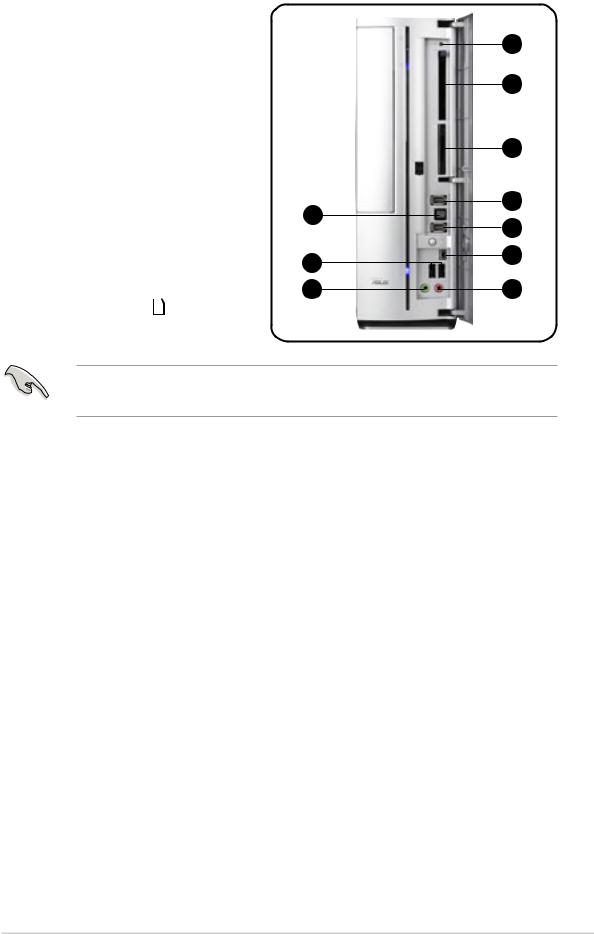
1.3Front panel (internal)
The optical drive, storage card reader, PCMCIA slot, and several I/O ports are located inside the front panel door.
Open the front panel doors by pressing the
 mark.
mark.
8.Reset button
 . Press this button to reset the system.
. Press this button to reset the system.
9.PCMCIA slot . This slot is for a PCMCIA-compliant card. See page 49 for details.
. This slot is for a PCMCIA-compliant card. See page 49 for details.
10.4-in-1 card slot  . This slot is for a storage cards.
. This slot is for a storage cards.
8
9
10
11
17
12
13
16
15 |
14 |
You can not close the front panel I/O door if a storage card is inserted in any of the card slots.
11.HDD security lock (optional). This port allows you to lock the HDD data with the supplied security key. See page 48 for details.
12.6-pin IEEE 1394 port
 . This port provides high-speed connectivity for IEEE 1394-compliant audio/video devices, storage peripherals, and other PC devices.
. This port provides high-speed connectivity for IEEE 1394-compliant audio/video devices, storage peripherals, and other PC devices.
13.4-pin IEEE 1394 port
 . This port provides high-speed connectivity for IEEE 1394-compliant audio/video devices, storage peripherals, and other PC devices.
. This port provides high-speed connectivity for IEEE 1394-compliant audio/video devices, storage peripherals, and other PC devices.
14.Microphone port  . This Mic (pink) port connects a microphone.
. This Mic (pink) port connects a microphone.
15.Headphone port . This port connects a headphone with a stereo mini-plug.
. This port connects a headphone with a stereo mini-plug.
16.USB 2.0 ports  2.0. These Universal Serial Bus 2.0 (USB 2.0) ports are available for connecting USB 2.0 devices such as a mouse, printer, scanner, camera, PDA, and others.
2.0. These Universal Serial Bus 2.0 (USB 2.0) ports are available for connecting USB 2.0 devices such as a mouse, printer, scanner, camera, PDA, and others.
17.Optical S/PDIF port  . This port connects your audio system for 5.1-channel surround sound and enhanced 3D audio.
. This port connects your audio system for 5.1-channel surround sound and enhanced 3D audio.
ASUS AB-P2800 book size barebone system |
13 |
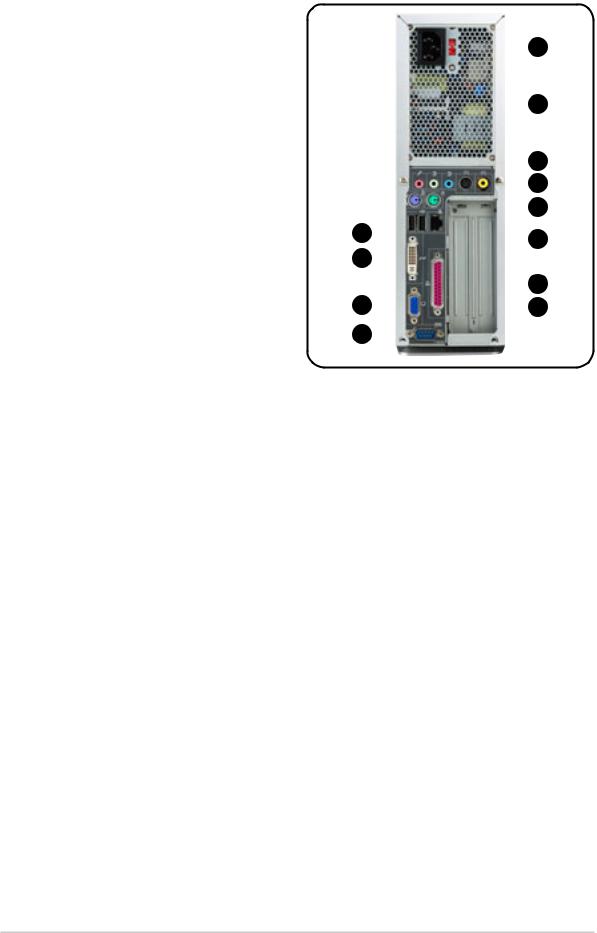
1.4Rear panel
The system rear panel includes the power socket and several I/O ports that allow convenient connection of devices.
1.Voltage selector. This switch allows you to select the appropriate voltage supply in your area. See the “Voltage selector” section on page 42 before adjusting this switch.
2.Power supply unit. This is a 200W power supply unit.
3.S-Video port 
 . This port connects a video cassette recorder, camcorder, or television with S-Video interface.
. This port connects a video cassette recorder, camcorder, or television with S-Video interface.
|
|
|
|
|
|
|
|
|
|
|
|
1 |
|||
|
|
|
|
|
|
|
|
|
|
|
|||||
|
|
|
|
|
|
|
|
|
|
|
|
|
2 |
||
|
|
|
|
|
|
|
|
|
|
|
|
|
|||
|
|
|
|
|
|
|
|
|
|
|
|
3 |
|||
|
|
|
|
|
|
|
|
|
|||||||
|
|
|
|
|
|
|
|
|
|
|
|
|
4 |
||
|
|
|
|
|
|
|
|
|
|
|
|
|
|||
12 |
|
|
|
|
|
|
|
|
|
5 |
|||||
|
|
|
|
|
|
|
|
||||||||
|
|
|
|
|
|
|
|
|
|
|
|
||||
|
|
|
|
|
|
|
|
|
|
|
|
6 |
|||
|
|
|
|
|
|
|
|
|
|
|
|
||||
|
|
|
|
|
|
|
|
|
|
|
|
||||
11 |
|
|
|
|
|
|
|
||||||||
|
|
|
|
|
|
|
|
|
|
|
|
7 |
|||
|
|
|
|
|
|
|
|
|
|
|
|
||||
10 |
|
|
|
|
|
|
|
|
|
||||||
|
|
|
|
|
|
|
|
|
|||||||
|
|
|
|
|
|
|
|
|
|||||||
|
|
|
|
|
|
|
|
|
8 |
||||||
|
|
|
|
|
|
|
|
|
|||||||
9 |
|
|
|
|
|
|
|
|
|
|
|
|
|
|
|
|
|
|
|
|
|
|
|
|
|
|
|
|
|
|
|
4.TV-out port. This port connects a television.
5.PS/2 mouse port  . This green 6-pin connector is for a PS/2 mouse.
. This green 6-pin connector is for a PS/2 mouse.
6.Ethernet LAN port  . This port allows connection to a Local Area Network (LAN) through a network hub.
. This port allows connection to a Local Area Network (LAN) through a network hub.
7.Parallel port  . This 25-pin port connects a printer, scanner, or other devices.
. This 25-pin port connects a printer, scanner, or other devices.
8.PCI slots. These PCI slots (covered) are for PCI-compliant cards.
9.Serial port  . This port connects a mouse, modem, or other devices that conforms with serial specification.
. This port connects a mouse, modem, or other devices that conforms with serial specification.
10.VGA port  . This port connects a VGA monitor.
. This port connects a VGA monitor.
11.DVI port. This port connects a flat panel or LCD display.
12.USB 2.0 ports  2.0. These Universal Serial Bus 2.0 (USB 2.0) ports are available for connecting USB 2.0 devices such as a mouse, printer, scanner, camera, PDA, and others.
2.0. These Universal Serial Bus 2.0 (USB 2.0) ports are available for connecting USB 2.0 devices such as a mouse, printer, scanner, camera, PDA, and others.
14 |
Chapter 1: System introduction |
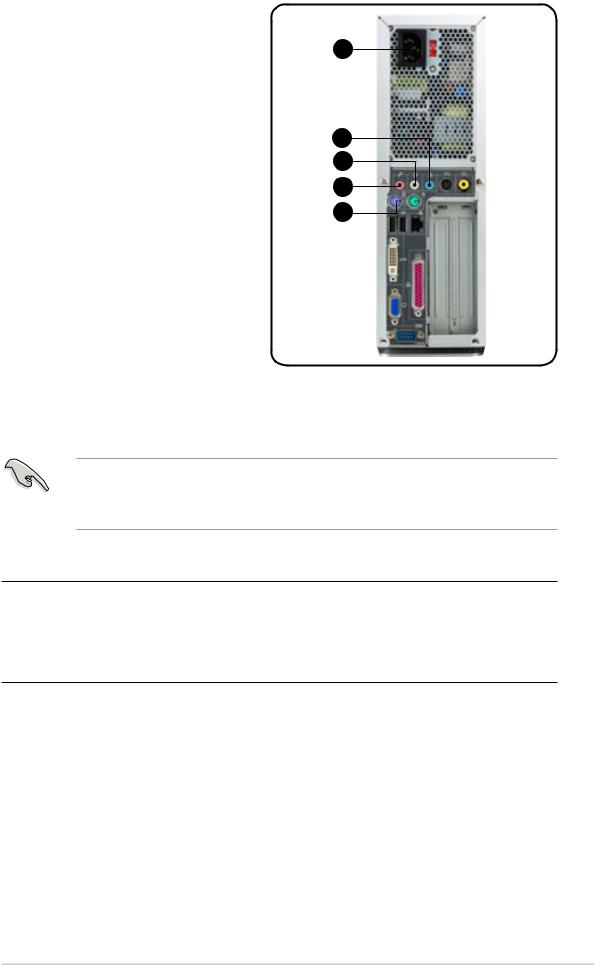
13.PS/2 keyboard port . This purple 6-pin connector is for a PS/2 keyboard.
. This purple 6-pin connector is for a PS/2 keyboard.
14.Microphone port  . This Microphone (pink) port connects a microphone. In 4/6-channel mode, the function of this port becomes Surround Speaker.
. This Microphone (pink) port connects a microphone. In 4/6-channel mode, the function of this port becomes Surround Speaker.
17
16
15
14
13
15.Line Out port . This Line Out (lime) port connects a headphone or a speaker. In 4/6-channel mode, the function of this port becomes Front Speaker Out.
. This Line Out (lime) port connects a headphone or a speaker. In 4/6-channel mode, the function of this port becomes Front Speaker Out.
16.Line In port . This Line In (light blue) port connects a tape player or other audio sources. In 6-channel mode, the function of this port becomes Low Frequency Enhanced Output/Center.
. This Line In (light blue) port connects a tape player or other audio sources. In 6-channel mode, the function of this port becomes Low Frequency Enhanced Output/Center.
The functions of the Line Out (lime), Line In (blue), and Microphone (pink) ports change when you select the 4-channel or 6-channel audio configuration as shown in the table below.
Audio ports function variation
Port |
Headphone/2-Channel |
4-Channel |
6-Channel |
|
|
|
|
Blue |
Line In |
No function |
LFE Output*/Center |
|
|
|
|
Lime |
Line Out |
Front Speaker Out |
Front Speaker Out |
|
|
|
|
Pink |
Mic In |
Surround |
Surround |
* Low Frequency Enhanced Output
17. Power socket. This socket connects the power cable and plug.
ASUS AB-P2800 book size barebone system |
15 |
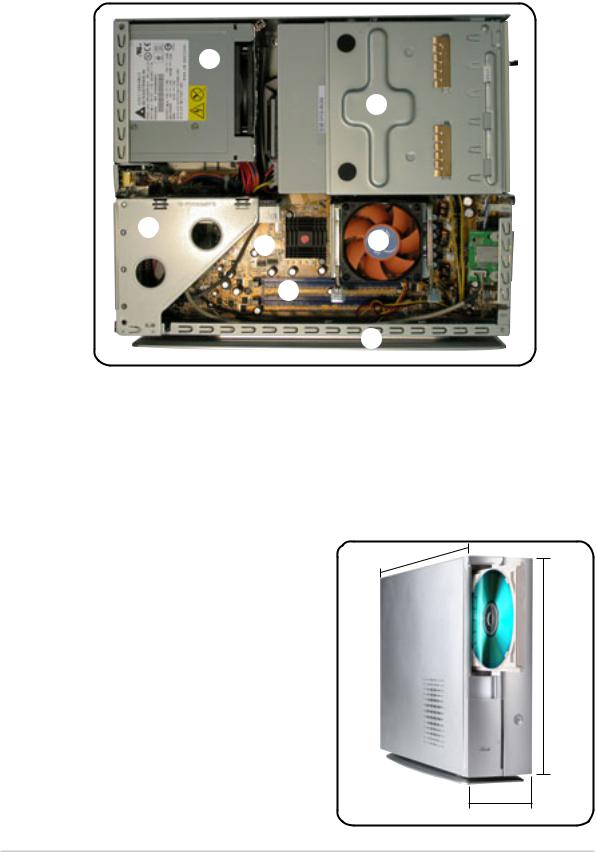
1.5Internal components
The illustration below is the internal view of the system when you remove the cover and the CPU fan duct. The installed components are labeled for your reference. Proceed to Chapter 2 for instructions on installing other system components.
4
1
|
2 |
|
6 |
|
3 |
|
|
|
|
5 |
|
|
|
|
7 |
1. |
Storage drive assembly |
5. |
DIMM sockets |
2. |
PCI riser |
6. |
CPU fan and heatsink assembly |
3. |
ASUS P4R8L motherboard |
7. |
Foot stand |
4. |
Power supply unit |
|
|
1.6System dimension
The ASUS booksize barebone system is ergonomically designed to fit and complement your desktop.
You may use the foot stand to place the system vertically on a flat, stable surface.
357mm
275mm
91mm
16 |
Chapter 1: System introduction |

Chapter 2
This chapter provides step-by-step instructions on how to install components to the system.
Basic installation
ASUS AB-P2800 book size barebone system
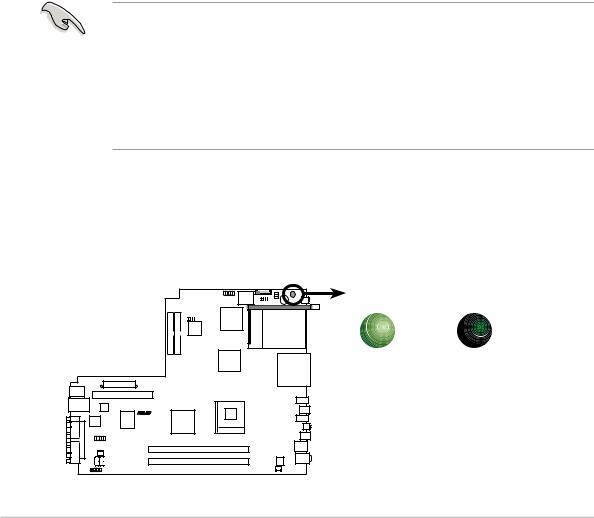
2.1Preparation
Before you proceed, make sure that you have all the components that you plan to install in the system.
Basic components to install
1.Central processing unit (CPU)
2.DDR Dual Inline Memory Module (DIMM)
3.Expansion card(s)
4.Hard disk drive
5.Optical drive
Tool
Phillips (cross) screw driver
2.2 Before you proceed
Take note of the following precautions before you install components into the system.
• Use a grounded wrist strap or touch a safely grounded object or to a metal object, such as the power supply case, before handling components to avoid damaging them due to static electricity.
•Hold components by the edges to avoid touching the ICs on them.
•Whenever you uninstall any component, place it on a grounded antistatic pad or in the bag that came with the component.
The system motherboard comes with an onboard standby power LED. When lit, this LED indicates that the system is ON, in sleep mode or in soft-off mode, and not powered OFF. Unplug the power cable from the power outlet and make sure that the standby power LED is OFF before installing any system component.
SB_PWR
|
|
|
|
|
|
ON |
OFF |
|
|
|
|
|
|
||
|
|
|
|
|
|
||
|
|
|
|
|
|
||
|
|
|
|
|
|
Standby |
Powered |
|
|
|
|
|
|
||
|
|
|
|
|
|
Power |
Off |
|
|
|
|
|
|
P4R8L
P4R8L Onboard LED
18 |
Chapter 2: Basic installation |

2.3 Removing the cover
To remove the cover:
1 |
1 |
|
|
|
|
|
|
|
|
|
|
|
|
|
|
|
|
|
|
|
|
|
|
1.On the rear panel, locate the two screws that secure the cover to the chassis.
3.Pull the cover slightly toward the rear panel until the cover tabs disengage from the chassis.
2.Use a Phillips (cross) screw driver to remove the cover screws. Keep the screws for later use.
4.Lift the cover, then set aside.
ASUS AB-P2800 book size barebone system |
19 |

2.4 Removing the storage drive assembly
Removing the storage drive assembly provides you more space when installing the CPU and the CPU fan and heatsink assembly.
To remove the front cover and storage drive assembly:
1.Lift the front cover hooks outward until they disengage from the chassis.
2.Carefully remove the front
cover, then set it aside. |
|
1 |
2 |
|
|
|
|
|
|
|
|
|
|
|
|
|
|
|
|
3.Lay the system on its side on a flat and stable surface.
4.Locate and remove three storage drive assembly screws. Keep the screws for later use.
4
If your system comes with a pre-installed optical drive, disconnect the power, audio, and IDE plugs at the back of the drive before lifting the storage drive assembly.
5. Slightly lift the storage drive |
5 |
|
|
|
assembly until its hooks are |
|
|
||
|
|
|||
released from the chassis |
|
|
|
|
holes. Set the storage drive |
|
|
|
|
assembly aside. |
|
|
|
|
|
|
|
|
|
|
|
|
|
|
When removing the storage drive assembly, make sure to hold or support it firmly. The assembly may accidentally drop and damage other system components.
20 |
Chapter 2: Basic installation |

2.5 Installing a CPU
The P4R8L motherboard comes with a surface mount 478-pin Zero Insertion Force (ZIF) socket specifically designed for Intel® Pentium® 4 processor. You need to remove the CPU fan duct and heatsink assembly before you could install a CPU.
2.5.1 Removing the CPU fan and heatsink assembly
The system package includes a pre-installed proprietary CPU fan and heatsink assembly with a fan duct to provide an efficient thermal solution to the system.
Do not replace the proprietary CPU fan and heatsink with other models.
1.Locate the CPU fan and heatsink assembly.
2.Remove the two screws that secure the fan duct on the CPU fan and heatsink assembly.
3.Lift the fan duct, then set aside.
ASUS AB-P2800 book size barebone system |
21 |
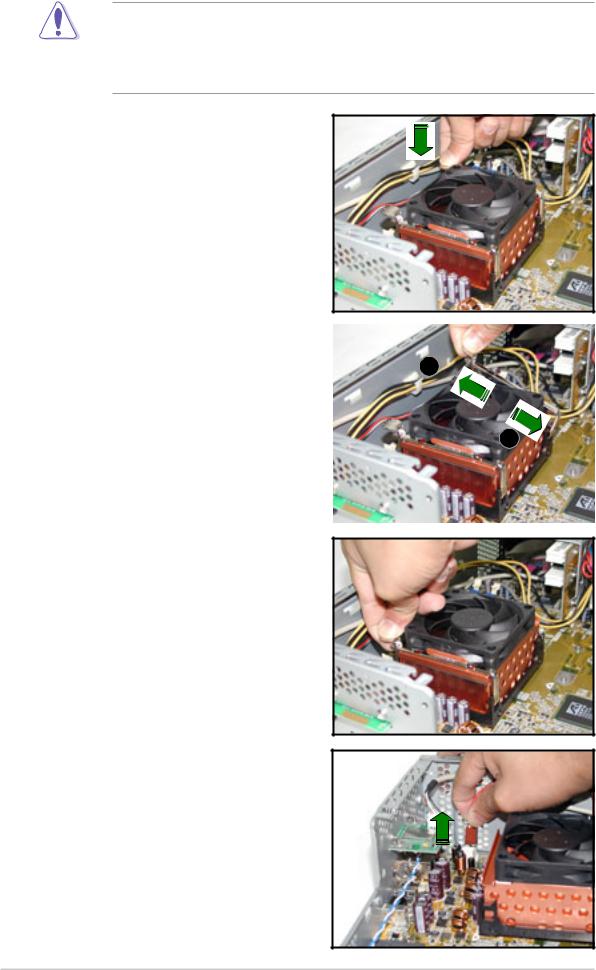
If a memory module is installed to the DIMM socket, remove the module first before removing the CPU fan and heatsink assembly to avoid damaging the DIMM. Refer to page 28 for details on how to remove the memory module(s).
4. Carefully press down the locking lever of the retention bracket.
5. |
Detach the retention bracket |
|
|
hook from the retention module |
5 |
|
hole by flipping the locking lever |
|
|
|
|
|
to the direction of the arrow. |
|
6. |
Detach the other retention |
6 |
|
bracket hook from the hole on |
|
|
the other side of the retention |
|
|
module. |
|
|
|
|
7.Remove the retention bracket, then set aside. Follow the same steps in removing the other retention bracket.
7
8.Disconnect the CPU fan cable from the CPU fan connector on the motherboard.
22 |
Chapter 2: Basic installation |
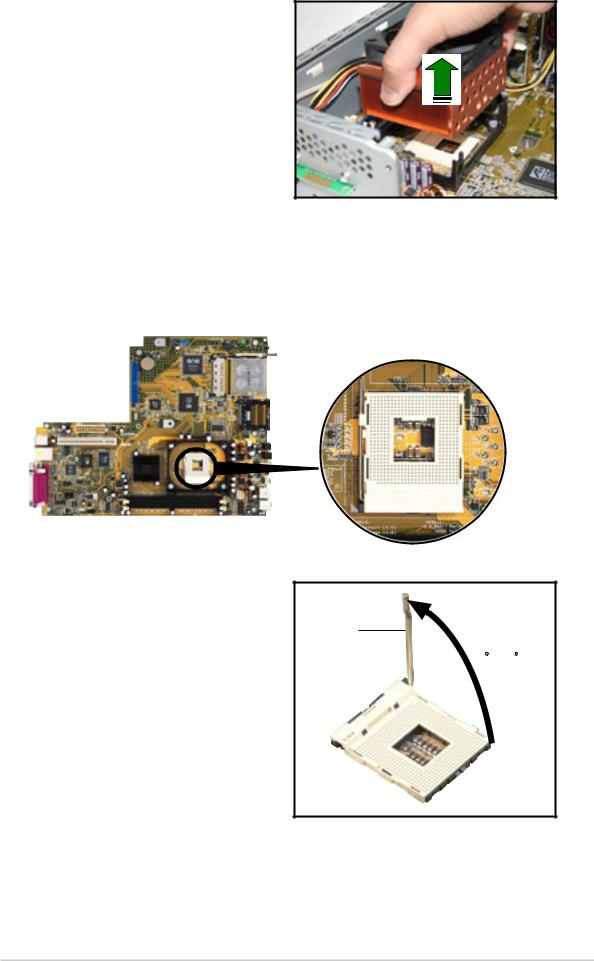
9.Slightly lift the CPU fan and heatsink assembly, then set aside.
2.5.2 CPU installation
To install the CPU:
1.Locate the 478-pin CPU socket on the motherboard.
2. Unlock the socket by pressing |
|
the lever sideways then lifting it |
Lever |
up to a 90° angle. |
90 - 100
ASUS AB-P2800 book size barebone system |
23 |

3. Position the CPU above the |
|
socket such that its marked |
|
corner (gold mark) matches the |
|
base of the socket lever. |
Gold mark |
|
4.Carefully insert the CPU into the socket until it fits in place.
The CPU fits only in one correct orientation. DO NOT force the CPU into the socket to prevent bending the pins and damaging the CPU!
5.Push down the socket lever to secure the CPU. The lever clicks on the side tab to indicate that it is locked.
2.5.3Re-installing the CPU fan and heatsink assembly
Install the CPU fan and heatsink assembly before installing the memory module to avoid damaging the DIMM.
To re-install the CPU fan and heatsink assembly:
1.Position the CPU fan and heatsink assembly on top of the installed CPU.
24 |
Chapter 2: Basic installation |
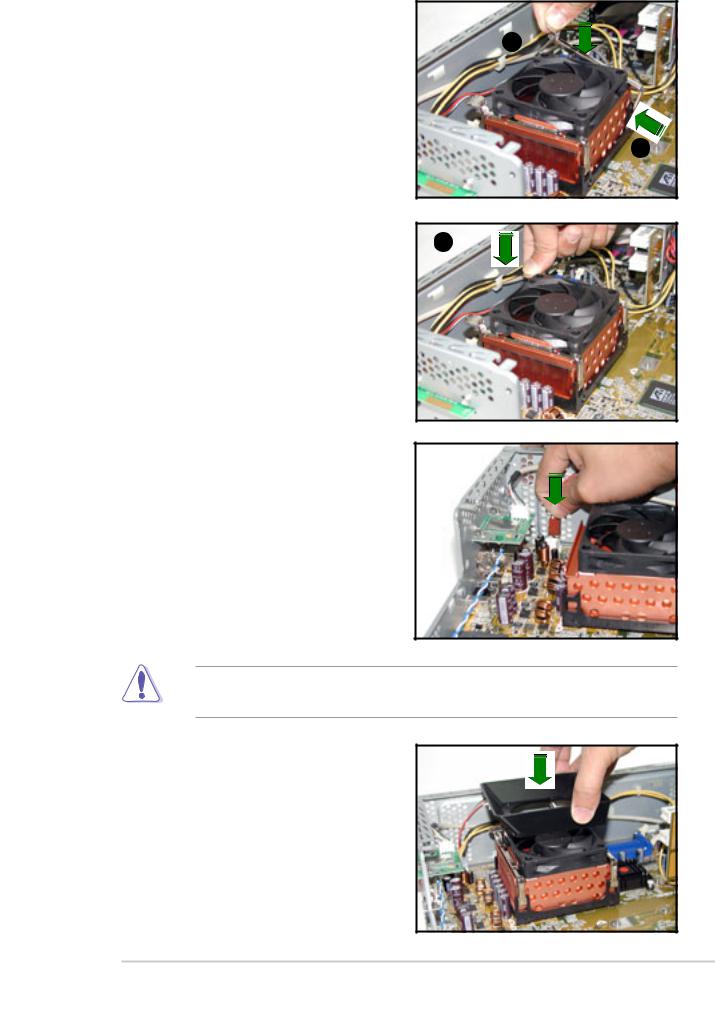
2. Align the retention bracket with
the rails on the side of the CPU
2
fan.
3.Attach the retention bracket hook in the retention module
hole.
3
4. Carefully press down the
4
retention bracket locking lever until its hook attaches to the retention module hole.
5.Follow steps 2 to 4 to re-install the second retention bracket.
6.Connect the CPU fan cable to
the CPU fan connector on the motherboard.
Install the memory module(s) before re-installing the fan duct. Refer to page 27 for details.
7. Position the fan duct on top of the CPU fan.
ASUS AB-P2800 book size barebone system |
25 |
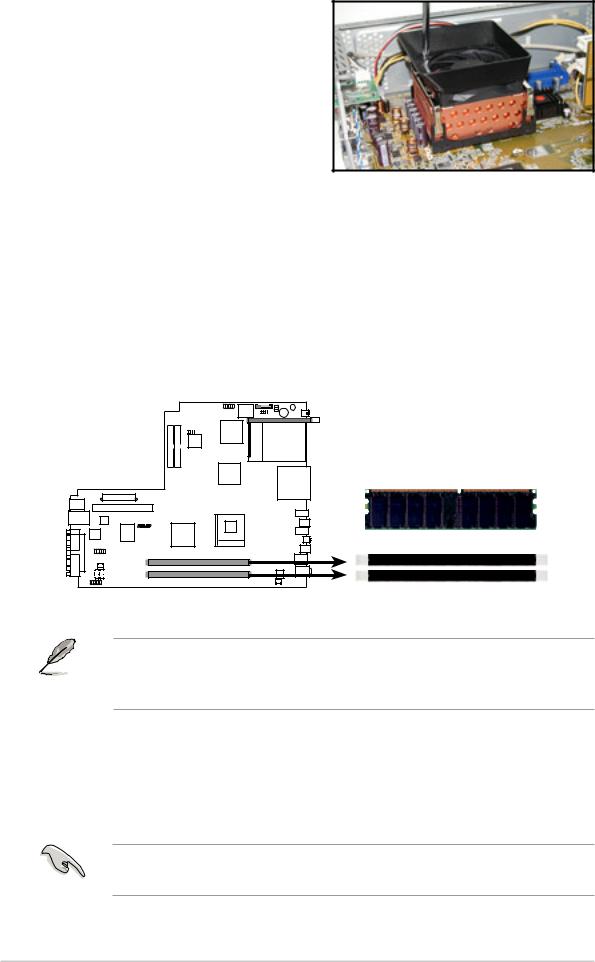
8.Secure the fan duct with two screws you earlier removed.
2.6 Installing memory modules
2.6.1 Overview
The system motherboard has two Double Data Rate (DDR) DIMM sockets that support up to 2GB non-ECC PC3200/2700/2100/1600 DDR SDRAM DIMMs. Each DIMM socket is double-sided. Refer to the illustration below for the location of the DIMM sockets.
|
|
|
|
|
|
|
|
|
|
104 Pins |
|
80 Pins |
|||||
|
|
|
|
|
|
|
|
|
|
|
|||||||
|
|
|
|
|
|
|
|
|
|
|
|||||||
|
|
|
|
|
|
|
|
|
|
|
|||||||
|
|
||||||||||||||||
|
|
|
|
|
|
|
|
|
|
|
|||||||
|
|
|
|
|
|
|
|
|
|
|
|
|
|
|
|
|
|
|
|
|
|
|
|
|
|
|
|
|
|
|
|
|
|
|
|
P4R8L
P4R8L 184-Pin DDR DIMM Sockets
For optimum compatibility, it is recommend that you obtain memory modules from the same vendor. Refer to section 2.6.3 for a list of qualified DDR400 vendors.
2.6.2 Memory configurations
You may install 64MB, 128MB, 256MB, 512MB, and 1GB DDR DIMMs to the DIMM sockets.
This motherboard may only detect PC2700 (DDR333) system memory when you install double-sided PC3200 (DDR400) DIMMs.
26 |
Chapter 2: Basic installation |
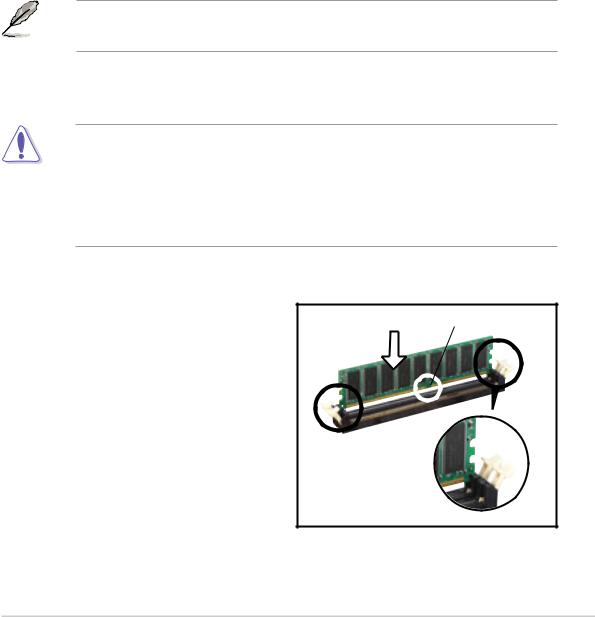
2.6.3 Qualified Vendor List
The following table lists the DDR400 memory modules that have been tested and qualified for use with this motherboard.
Size |
Vendor |
Model |
Brand |
Component |
256MB |
NANYA |
NT256D64S88V1G-5T |
NANYA |
200608PT |
256MB |
KINGSTON |
KVR400X64C25/256 |
WINBOND |
W942508BH-5 |
256MB |
TWINMOS |
M2G9108AIATT9F018AADT |
TWINMOS |
TMD7608F8E50D |
256MB |
INFINEON |
22-T003C1127 |
INFINEON |
HYB25D256800BT-5 |
256MB |
ADATA |
MD0AD5F3C31YB1EZ2 |
ADATA |
ADD8608A8A-5B |
256MB |
HYNIX |
PC3200U-30330 |
HYNIX |
HYMD232646V8J-D43 |
256MB |
TWINMOS |
231M52034480042 |
WINBOND |
W942508BH-5 |
256MB |
SAMSUNG |
M368L3223DTM-CC4 |
SAMSUNG |
K4H560838D-TCC4 |
256MB |
PSC |
960AL5D8B53TA1-5B |
PSC |
A2S56D30BTP |
|
|
|
|
|
Obtain DDR DIMMs only from ASUS qualified vendors. Visit the ASUS website (www.asus.com) for the latest QVL.
2.6.4 Installing a DIMM
•Make sure to unplug the power supply before adding or removing
DIMMs or other system components. Failure to do so may cause severe damage to both the motherboard and the components.
•Re-install the CPU fan and heatsink assembly before installing the DIMM(s) to avoid damaging the memory module(s).
Follow these steps to install a DIMM.
1.Locate the DIMM sockets in the motherboard.
2.Unlock a DIMM socket by pressing the retaining clips outward.
3.Align a DIMM on the socket such that the notch on the DIMM matches the break on the socket.
DDR DIMM notch
Unlocked retaining clip
ASUS AB-P2800 book size barebone system |
27 |

4.Firmly insert the DIMM into the socket until the retaining clips snap back in place and the DIMM is properly seated.
A DDR DIMM is keyed with a notch so that it fits in only one direction. DO NOT force a DIMM into a socket to avoid damaging the DIMM.
Locked retaining clip
2.6.5 Removing a DIMM
Follow these steps to remove a DIMM.
1.Simultaneously press the retaining clips outward to unlock the DIMM.
Support the DIMM lightly with your fingers when pressing the retaining clips. The DIMM might get damaged when it flips out with extra force.
2.Remove the DIMM from the socket.
Remove the memory module before removing the CPU fan and heatsink assembly. Incorrect installation sequence may damage the DIMM(s).
28 |
Chapter 2: Basic installation |

2.7Installing PCI cards
In the future, you may need to install PCI cards to the system. The system motherboard has one PCI slot with a pre-installed PCI riser assembly that supports two PCI cards.
Make sure to unplug the power cord before adding or removing expansion cards. Failure to do so may cause you physical injury and damage motherboard components.
2.7.1 PCI slots
The PCI slots support PCI cards such as a LAN card, SCSI card, USB card, and other cards that comply with PCI specifications. The following figure shows a LAN card installed on a PCI slot.
2.7.2 PCI card installation
To install a PCI card:
1.Slightly lift the PCI riser assembly until it disengages from the chassis.
PCI riser assembly
ASUS AB-P2800 book size barebone system |
29 |
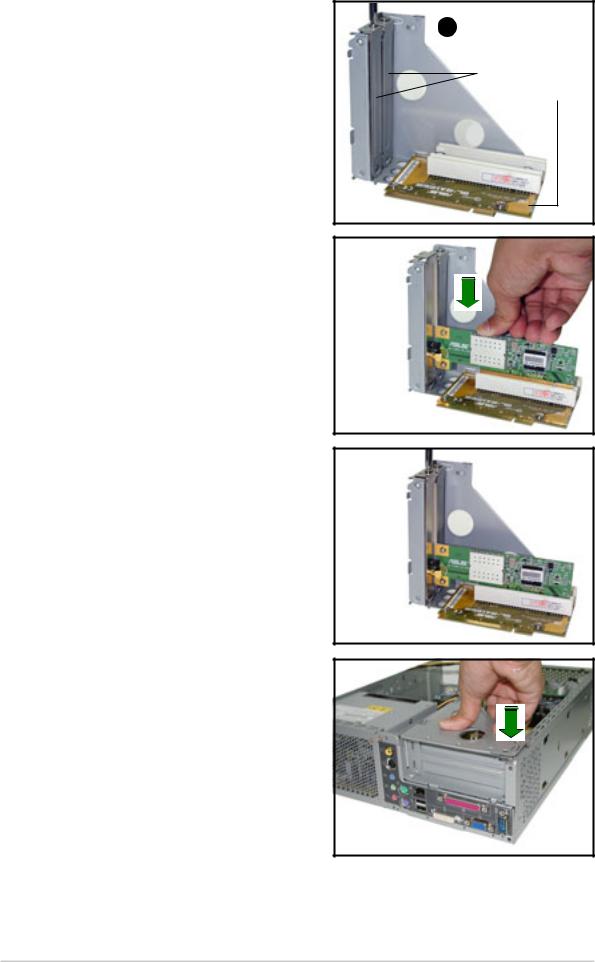
2.Place the PCI riser asembly on a flat surface.
3.Remove the bracket opposite the PCI slot you wish to use. Keep the screw for later use.
4.Align the PCI card connector with the slot and press firmly until the card is completely seated on the slot.
5.Secure the PCI card to the PCI riser assembly with the screw you removed earlier.
6.Re-install the PCI riser assembly to the system chassis.
3
PCI slot brackets PCI riser card
30 |
Chapter 2: Basic installation |
